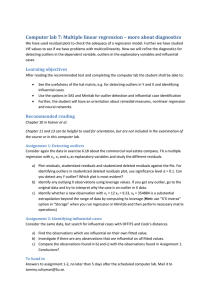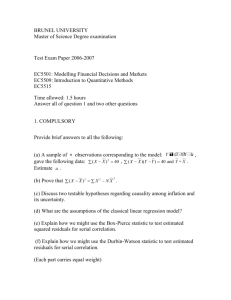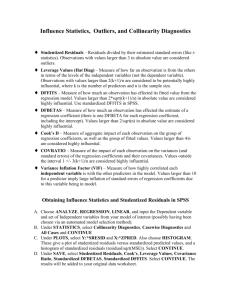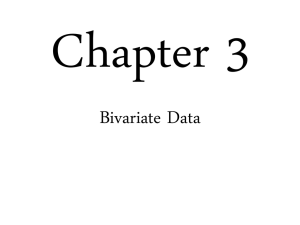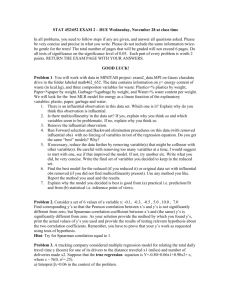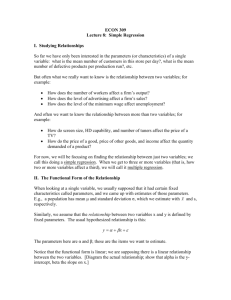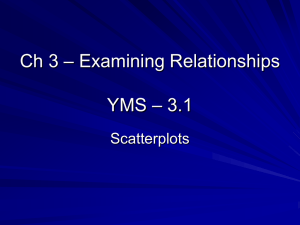Section 4.3: Diagnostics on the Least
advertisement
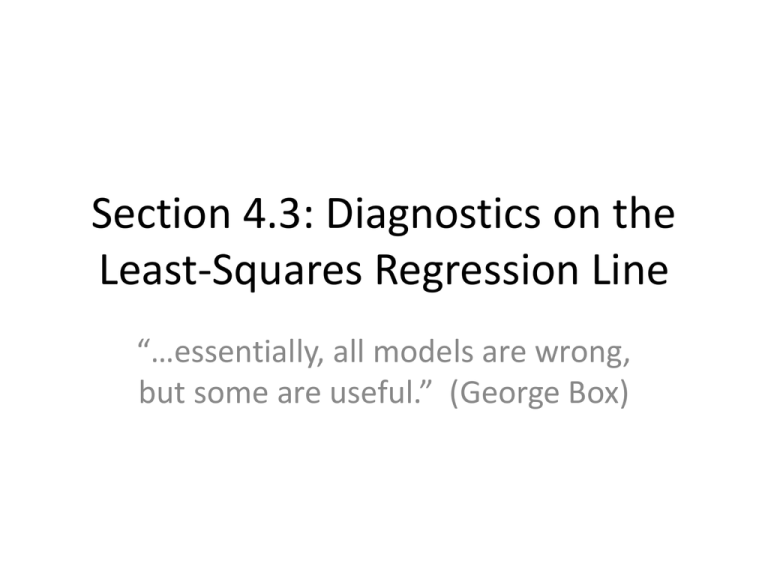
Section 4.3: Diagnostics on the Least-Squares Regression Line “…essentially, all models are wrong, but some are useful.” (George Box) Just because you can fit a linear model to the data doesn’t mean the linear model describes the data well. Every model has assumptions. – Linear relationship between X and Y – Errors distributed by Normal (bell-shaped) distribution – Variance of errors equal throughout range – Each observation independent of one another Residual analysis is one common tool for checking assumptions. Residual = Observed – Predicted Least-squares line minimizes “sum of the squared residuals” 𝑂𝑏𝑠𝑒𝑟𝑣𝑒𝑑 − 𝑃𝑟𝑒𝑑𝑖𝑐𝑡𝑒𝑑 190 Observed and Predicted Asking Price re s 175 170 165 160 155 asking id ua l 180 185 Observed Asking Predicted Asking 1100 1200 1300 sqft 1400 1500 2 • Residuals play an important role in determining the adequacy of the linear model. In fact, residuals can be used for the following purposes: • To determine whether a linear model is appropriate to describe the relation between the predictor and response variables. • To determine whether the variance of the residuals is constant. • To check for outliers. The first step is to fit the model and then… • Calculate predicted y values for each x. • Calculate residuals for each x. • Then plot either residuals (y-axis) against either the observed y values or (preferred) predicted y values. 4-6 EXAMPLE Is a Linear Model Appropriate? A chemist has a 1000gram sample of a radioactive material. She records the amount of radioactive material remaining in the sample every day for a week and obtains the following data. 4-7 Day 0 1 2 3 4 5 6 7 Weight (in grams) 1000.0 897.1 802.5 719.8 651.1 583.4 521.7 468.3 Linear correlation coefficient: – 0.994 4-8 4-9 4-10 Linear model not appropriate If a plot of the residuals against the explanatory variable shows the spread of the residuals increasing or decreasing as the explanatory variable increases, then a strict requirement of the linear model is violated. This requirement is called constant error variance. The statistical term for constant error variance is homoscedasticity. 4-11 4-12 A plot of residuals against the explanatory variable may also reveal outliers. These values will be easy to identify because the residual will lie far from the rest of the plot. 4-13 4-14 An influential observation is an observation that significantly affects the least-squares regression line’s slope and/or y-intercept, or the value of the correlation coefficient. 4-15 Explanatory, x Influential observations typically exist when the point is an outlier relative to the values of the explanatory variable. So, Case 3 is likely influential. 4-16 4-17 With influential Without influential 4-18 As with outliers, influential observations should be removed only if there is justification to do so. When an influential observation occurs in a data set and its removal is not warranted, there are two courses of action: (1) Collect more data so that additional points near the influential observation are obtained, or (2) Use techniques that reduce the influence of the influential observation (such as a transformation or different method of estimation - e.g. minimize absolute deviations). 4-19 The coefficient of determination, R2, measures the proportion of total variation in the response variable that is explained by the least-squares regression line. The coefficient of determination is a number between 0 and 1, inclusive. That is, 0 < R2 < 1. If R2 = 0 the line has no explanatory value If R2 = 1 means the line explains 100% of the variation in the response variable. 4-20 R2 In simple linear regression R2 = correlation2 In general, R2 =1– 𝑣𝑎𝑟𝑖𝑎𝑛𝑐𝑒 𝑜𝑓 𝑟𝑒𝑠𝑖𝑑𝑢𝑎𝑙𝑠 𝑣𝑎𝑟𝑖𝑎𝑛𝑐𝑒 𝑜𝑓 𝑦 𝑣𝑎𝑙𝑢𝑒𝑠 Which is essentially a comparison of the linear model with a slope equal to zero versus model with slope not equal to zero. A slope equal to 0 implies Y value doesn’t depend upon X value. The data to the right are based on a study for drilling rock. The researchers wanted to determine whether the time it takes to dry drill a distance of 5 feet in rock increases with the depth at which the drilling begins. So, depth at which drilling begins is the predictor variable, x, and time (in minutes) to drill five feet is the response variable, y. Source: Penner, R., and Watts, D.G. “Mining Information.” The American Statistician, Vol. 45, No. 1, Feb. 1991, p. 6. 4-22 4-23 Draw a scatter diagram for each of these data sets. For each data set, the variance of y is 17.49. 4-24 Data Set A Data Set B Data Set C Data Set A: 99.99% of the variability in y is explained by the least-squares regression line Data Set B: 94.7% of the variability in y is explained by the least-squares regression line Data Set C: 9.4% of the variability in y is explained by the least-squares regression line 4-25


